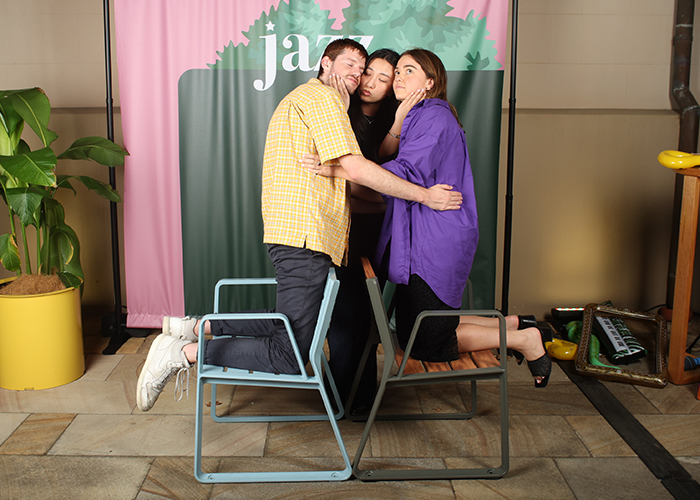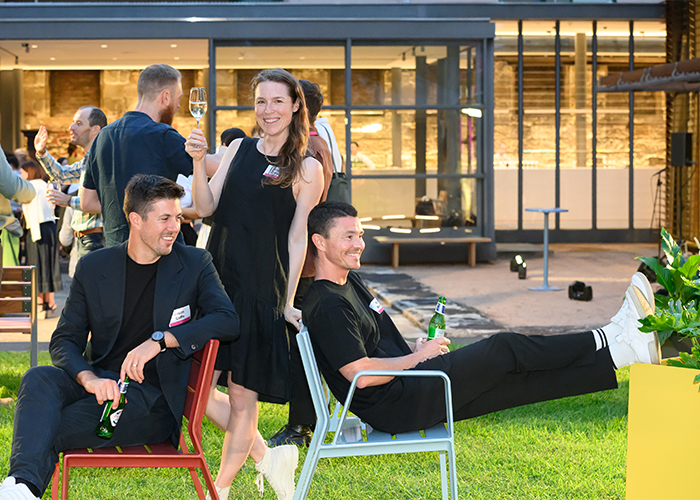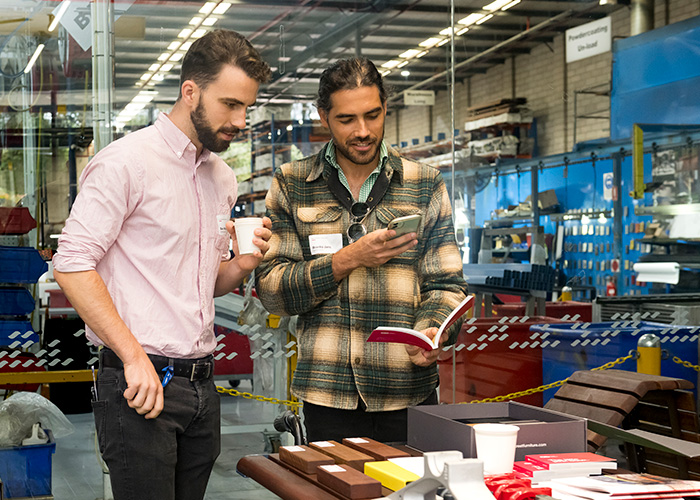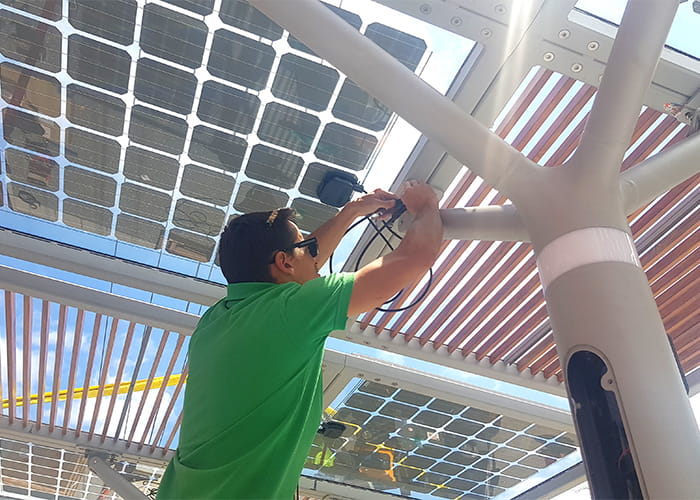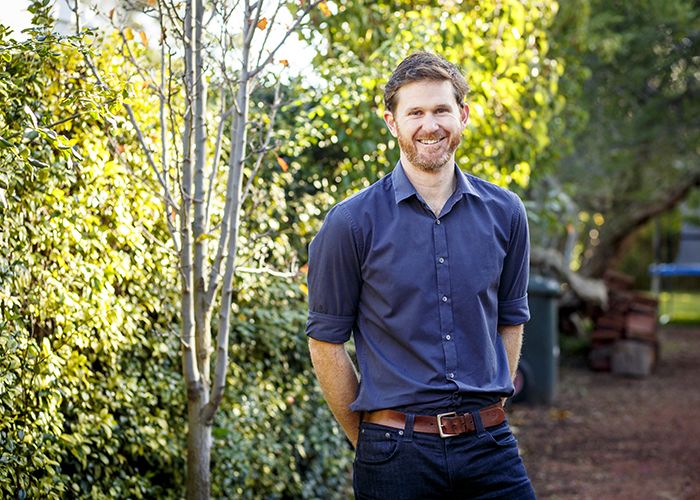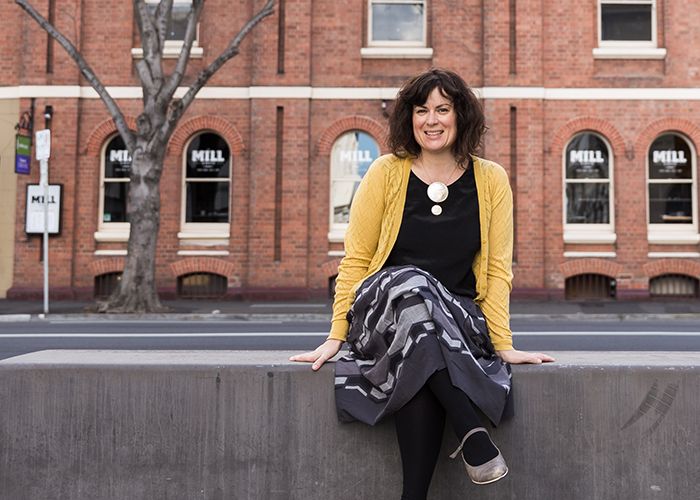
Sarah Bendeich with her Hobart Waterfront upgrade project in Morrison Street. Photo: Natalie Mendham
As Infrastructure Planner for the City of Hobart, Sarah Bendeich is a landscape architect helping to shape the city’s future. She shares her work with StreetChat.
The story behind this photo?
I’m sitting on a precast concrete bench which was part of a streetscape upgrade in the Hobart Waterfront in Morrison Street – I was the project landscape architect.
Morrison Street is being rolled out incrementally and will eventually provide a generous shared promenade linking one side of the Intercity Cycleway with Battery Point.
This photo is from stage one of that project.
The bench appears to hover on light at night time – it’s lit underneath. It’s five metres long and part of its function is as a vehicular barrier – we closed through traffic in Post Street as part of the pedestrian amenity improvements.
Please, tell us about yourself. What drew you to landscape architecture?
I’m really interested in the connection that humans have to places.
I enjoyed a really normal Australian suburban childhood – although I enjoyed more freedom and adventure than my own kids do. Camping at the coast in summer, winter weekends horse riding with friends and riding bikes through the streets, building cubbies in vacant lots after school – until the street lights came on.
These experiences cultivated a love of being outside and fond memories of specific places which I still carry with me.
Even my grandparents’ post-war inner Melbourne backyard – concrete, a hills-hoist, a workshop and a massive lemon tree, is a special place of memory.
I grew into an idealistic teenager who wanted to save the world but had no idea where to start. Ultimately my interests in environmental and social systems, geography, theory and design have come together in landscape architecture.
More recently I’ve studied environmental planning which led me to local government.
Landscape architects are in a good position to be able to influence the livability and sustainability of our cities. Healthy communities are supported by walkable, connected and well-designed places.
I think ultimately it’s the overlapping between natural systems, urban infrastructure, communities and human wellbeing that offers great scope for positive change.
As AILA Tasmania’s President, where do you see the chapter heading?
We are such a tiny group compared with the other states, however we have a really energised membership at the moment.
Engaging the local members, while connecting with the broader built environment allied professional community is important in such a small place where ultimately, we need all the collaborative opportunities we can get.
So in many of our activities – such as the long-running City Talks – we include architects, planners, engineers, politicians and the general public.
Where do I see the chapter heading? Right now, literally for the stars.
Something we’re excited about is an advocacy initiative, in collaboration with some other interested folk, to raise awareness and protect Tasmania’s dark night skies.
The night sky and all of those stars is a type of wilderness that needs protection if we are to maintain it for future generations.
Urban light pollution is a rapidly emerging problem in cities around the world, and losing the darkness is not just an aesthetic loss.
There is now evidence of significant impacts of cool bright light on human and ecosystem health. We are blessed with stunning night skies in Tasmania – people come here to view the stars – and we have the potential to protect and celebrate that.
Can you tell us about your role as Infrastructure Planner with the City of Hobart?
I’ve recently started a new role within City Infrastructure Division, planning and managing a program of local retail precinct streetscape projects to be delivered over the next six years.
These projects will improve the livability of Hobart’s suburbs and the vibrancy of local main streets, providing welcoming spaces with street trees, art and furniture, encouraging people to walk to the local shops, meet friends and do their shopping.
The aim is to make these streets more people focused, and less car-oriented.
While the projects have been initiated and prioritised already, in many ways we’re right at the beginning, scoping the projects, engaging stakeholders and getting the project teams together. I won’t be designing these projects, however I’m excited to be working at this earlier stage in the process.
What is your vision for Hobart?
Hobart’s landscape is breathtakingly beautiful. The city sits between Mount Wellington and the River Derwent in the most lovely way.
I’m a Melbourne girl originally, I’ve been here for 13 years and I still get a little jolt of joy when I head out to start my day. I step out the front door and I can see the bush up on the foothills, the air is so clean, and then I ride my bike down the hill to the office in Sullivans Cove – and I’m there in less than 10 minutes.
But looking beyond the obvious treasures of this city, my vision for Hobart is no different really than my vision for all of Australia’s cities – it starts with a dense urban core with housing options for people of all ages, so that people can live close to employment and services.
Creative re-use of our wonderful heritage buildings, walkable streets and spaces in between buildings that are full of life, trees and green spaces.
Good public transport options, a network of bike infrastructure so that active commuting is a real option for many people.
A sustainable economy and a resilient, connected, creative community.
What are you excited to be working on with your team right now?
The retail precincts projects are going to keep me busy for a number of years, however another project that I’m really excited about is an interpretation plan and new interpretation signage for Sullivans Cove.
The current signs were installed in 1988 for the bicentenary, so they are well and truly due for a refresh. The Cove is increasingly a gateway to the city for visitors arriving by cruise ship, and it is also the city’s main events precinct – so there is a big audience to reach.
And of course Hobart is rich with history, so there are many stories to tell. I am particularly excited that Aboriginal stories will be integrated into this work – as these were absent from the bicentennial panels.
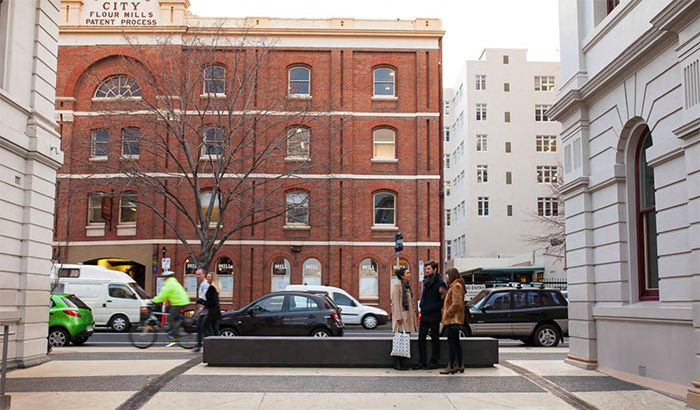
By day: The Hobart Waterfront upgrade project in Morrison Street. Photo: Hobart City Council
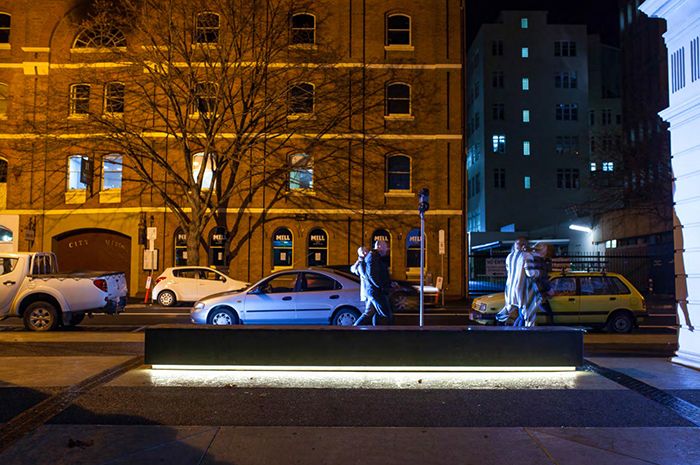
By night: The Hobart Waterfront upgrade project in Morrison Street. Photo: Hobart City Council
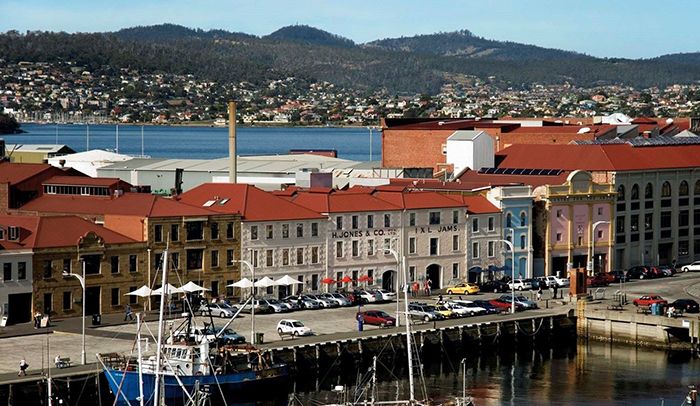
Historic Hobart: Sullivans Cove, the Hunter Street precinct and Constitution Dock. Photo: Henry Jones Art Hotel
In Profile is a Q&A series featuring Australian influencers of the public realm.
Interviewees are players in the public sphere with compelling stories, not always landscape architects or affiliated with SFA.
To nominate a subject, please contact the editor via editor@streetfurniture.com




